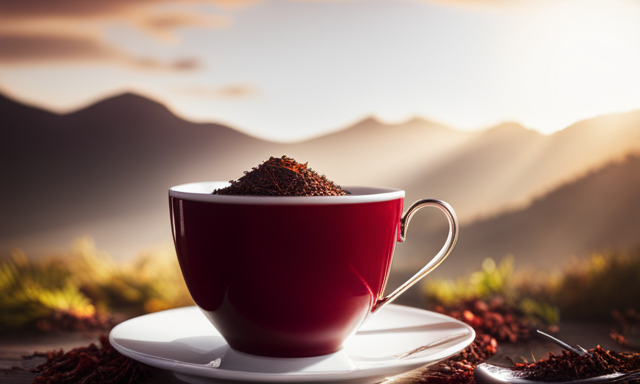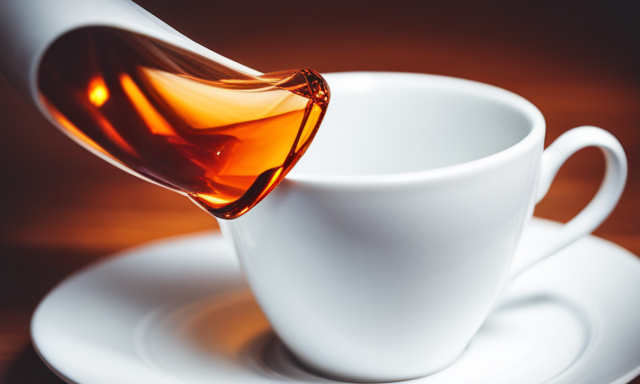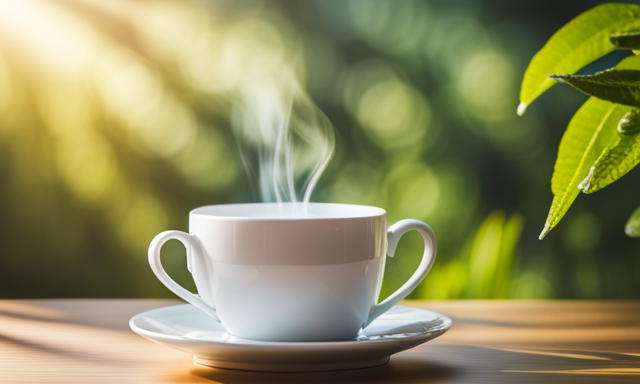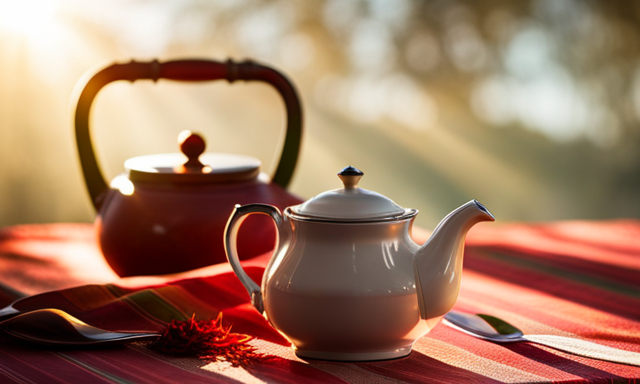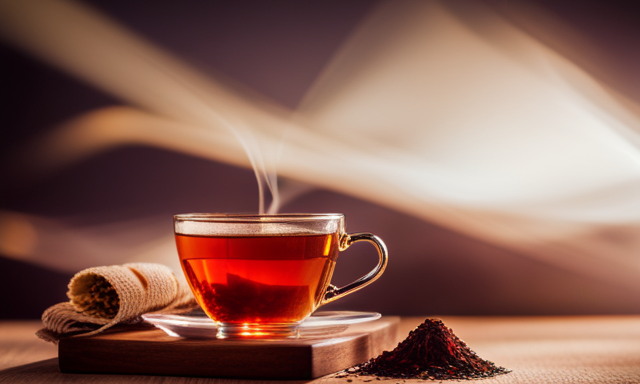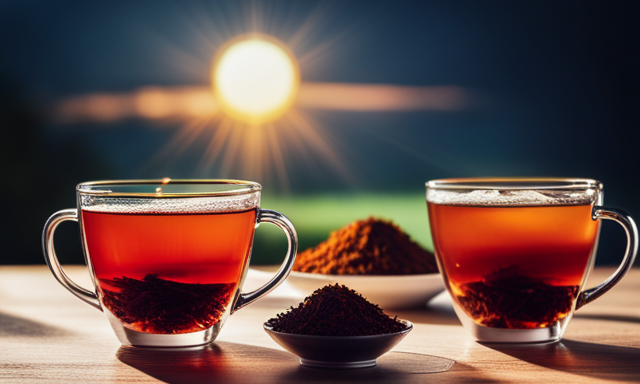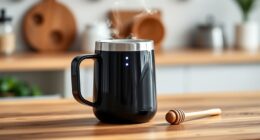As I sit here, savoring a warm cup of rooibos tea, I am reminded of the comforting embrace it offers. Rooibos tea, with its rich flavor and numerous health benefits, has become a staple in my daily routine.
But the question that often arises is, how much loose rooibos tea should one use per cup?
In this article, I will guide you through the art of measuring the perfect amount of loose rooibos tea to ensure a delightful and flavorful experience. From understanding the flavor profile of rooibos tea to experimenting with different combinations, I will provide you with the knowledge to create a cup of rooibos tea that suits your taste preferences.
Whether you prefer a strong and robust infusion or a lighter, more delicate flavor, I will show you how to adjust the tea strength to your liking.
So, join me on this journey as we unlock the secrets to brewing the perfect cup of rooibos tea.
Key Takeaways
- Use a heaping teaspoon of loose rooibos tea per cup
- Adjust tea strength by increasing or decreasing brewing time
- Whole leaf rooibos tea offers a more robust flavor compared to cut leaves
- Tea to water ratio is generally one teaspoon per 8 ounces of water
Understanding the Flavor Profile of Rooibos Tea
If you’re looking to fully appreciate the rich and earthy flavor of rooibos tea, you’ll want to understand its unique flavor profile. Rooibos tea has a distinct taste that can be described as naturally sweet and nutty with hints of vanilla and caramel.
To fully analyze its flavor profile, it’s important to consider the brewing techniques. Rooibos tea is best steeped in boiling water for about 5-7 minutes to extract its full flavor. This longer steeping time allows the tea to release its natural oils and essential compounds, resulting in a more robust and flavorful cup.
By understanding the flavor profile analysis and using the right brewing techniques, you can ensure that each cup of loose rooibos tea is bursting with its unique flavors.
Now let’s move on to choosing the right loose rooibos tea leaves.
Choosing the Right Loose Rooibos Tea Leaves
When it comes to choosing the right loose rooibos tea leaves, there are two main considerations to keep in mind: whole leaf vs. cut leaves, and organic vs. conventionally grown.
Whole leaf rooibos tea leaves are typically considered to be of higher quality and offer a more robust flavor profile, while cut leaves may brew faster but may lack some of the complexity.
Additionally, opting for organic rooibos tea ensures that no harmful pesticides or chemicals were used in its production, while conventionally grown tea may have been exposed to these substances.
Whole Leaf vs. Cut Leaves
To get the perfect cup of rooibos tea, simply measure out a heaping teaspoon of loose leaves per cup, allowing the whole leaves to infuse your senses with their vibrant flavor and soothing aroma.
Whole leaf rooibos tea offers a range of benefits that make it a popular choice among tea enthusiasts. The intact leaves retain more of their natural oils and flavors, resulting in a richer and more robust brew. They also have a longer shelf life and can be steeped multiple times without losing their potency.
On the other hand, cut rooibos leaves may have a slightly shorter shelf life and can sometimes produce a weaker brew.
Now, let’s move on to the next section, where we will explore the differences between organic and conventionally grown rooibos tea.
Organic vs. Conventionally Grown
Discover the distinct advantages of choosing organic over conventionally grown rooibos for a truly exceptional tea experience. Organic farming practices prioritize the use of natural fertilizers and pest control methods, resulting in a healthier and more sustainable product. When you opt for organic rooibos, you can rest assured that no harmful pesticides or chemicals haven’t been used in its cultivation.
This not only benefits your health but also supports the environment by reducing pollution and preserving biodiversity. Additionally, organic farming promotes soil health and fertility, ensuring the highest quality tea leaves. So, when it comes to enjoying a cup of rooibos tea, why settle for anything less than the purest and most flavorful option?
Now, let’s move on to measuring the correct amount of loose rooibos tea for the perfect brew.
Measuring the Correct Amount of Loose Rooibos Tea
The key is using the right amount of loose rooibos tea to achieve the perfect cup. Measuring accuracy is essential in order to get the best flavor and strength.
One important factor to consider is the tea to water ratio. For a standard cup of rooibos tea, a general guideline is to use one teaspoon of loose tea per 8 ounces of water. However, this can be adjusted depending on personal preference. Some people may prefer a stronger cup of tea and choose to use a heaping teaspoon, while others may prefer a milder flavor and opt for a level teaspoon. It’s all about finding the right balance that suits your taste buds.
Adjusting the tea strength to your preference is the next step in creating the perfect cup of rooibos tea.
Adjusting the Tea Strength to Your Preference
When adjusting the tea strength to my preference, I pay close attention to the brewing time and water temperature. I find that increasing the brewing time can result in a stronger flavor, while decreasing it can produce a milder taste.
Additionally, using hotter water temperature tends to extract more flavor from the tea leaves, resulting in a bolder cup of tea. By experimenting with these variables, I can tailor the tea strength to suit my personal taste preferences.
Brewing Time
For the perfect cup of rooibos tea, let the loose leaves steep for the recommended amount of time. Brewing techniques play a crucial role in determining the infusion duration. The longer the leaves steep, the stronger the flavor becomes.
Generally, rooibos tea requires a steeping time of 5-7 minutes. This allows the leaves to release their natural oils and flavors, resulting in a rich and aromatic cup of tea. However, it’s important to note that steeping time can vary depending on personal preference. Some individuals prefer a shorter steeping time for a milder taste, while others enjoy a longer infusion for a bolder flavor.
As we move on to the next section about water temperature, it’s essential to find the perfect balance between steeping time and water heat to achieve the desired strength and taste.
Water Temperature
To achieve the desired strength and taste of your brew, it’s crucial to find the perfect balance between steeping time and water heat. The water temperature plays a significant role in extracting the flavors from loose rooibos tea. Generally, rooibos tea requires hot, but not boiling, water to bring out its delicate flavors.
The ideal water temperature for steeping rooibos tea is around 195°F (90°C). This temperature allows the tea to steep properly without the risk of scorching the leaves or extracting bitter compounds. Steeping rooibos tea at this temperature for 5-7 minutes will ensure a full-bodied and flavorful cup.
Moving on to the next section about using a tea infuser or tea bag, let’s explore the different methods to prepare your perfect cup of rooibos tea.
Using a Tea Infuser or Tea Bag
Enjoy the rich and soothing flavors of loose rooibos tea by simply placing a tea infuser or tea bag in your cup and experiencing the comforting embrace of every sip. Using loose leaf tea allows for a more authentic and customizable brewing experience compared to pre-packaged tea. The larger leaves in loose tea provide a fuller flavor and a more robust cup of tea.
A tea infuser or tea bag helps to contain the loose leaves, making it easier to brew and enjoy without the hassle of straining. To properly store loose rooibos tea and maintain its freshness, transfer it to an airtight container and store it in a cool, dry place away from direct sunlight. This ensures that the tea retains its flavor and aroma for longer periods.
Transitioning into the next section on proper storage techniques, it’s important to keep in mind the importance of preserving the quality of loose rooibos tea.
Properly Storing Loose Rooibos Tea
When it comes to properly storing loose rooibos tea, there are two key points to consider: container selection and ideal storage conditions. First, it’s important to choose a container that’s airtight and opaque to protect the tea from light and air exposure.
Second, the ideal storage conditions for loose rooibos tea include keeping it in a cool and dry place, away from direct sunlight and strong odors. By following these guidelines, you can ensure that your loose rooibos tea stays fresh and flavorful for a longer period of time.
Container Selection
Choose a cup that can hold the perfect portion of loose rooibos tea. When selecting a container for your tea, consider the following options:
-
A ceramic teapot: This traditional option allows for easy steeping and keeps your tea warm for longer periods.
-
A glass infuser mug: This transparent option allows you to watch the tea leaves unfurl and enjoy the visual experience while brewing.
-
A stainless steel tea strainer: This versatile option fits into most cups and is ideal for those who prefer a more minimalist approach.
-
A porcelain gaiwan: This Chinese tea vessel is perfect for multiple infusions, offering a unique and traditional way to enjoy rooibos tea.
By choosing the right container, you can enhance your steeping techniques and fully enjoy the flavors of loose rooibos tea.
Now, let’s explore the ideal storage conditions for preserving its freshness.
Ideal Storage Conditions
To ensure your loose rooibos tea stays fresh, it’s important to store it under ideal conditions. The ideal temperature for storing rooibos tea is around 65 to 75 degrees Fahrenheit. It’s best to keep the tea in an airtight container away from direct sunlight, moisture, and strong odors. This will help preserve its flavors and prevent it from becoming stale.
Additionally, it’s recommended to use the tea within 6 to 12 months of purchasing it for the best flavor experience. When steeping rooibos tea, a recommended time is 5 to 7 minutes to extract its full flavor.
Now that you know how to store and steep your rooibos tea properly, let’s move on to experimenting with different flavor combinations.
Experimenting with Flavor Combinations
For a more adventurous taste, try mixing different flavors of loose rooibos tea together in your cup. Did you know that over 20% of tea drinkers enjoy experimenting with flavor combinations? It’s a fun way to discover unique and delightful taste experiences.
Here are three flavor pairings to get you started:
-
Citrus Burst: Combine a tangy lemon rooibos with a zesty orange rooibos for a refreshing and invigorating blend.
-
Spiced Delight: Mix a warm cinnamon rooibos with a hint of nutmeg rooibos for a cozy and comforting cup of tea.
-
Floral Infusion: Blend a fragrant lavender rooibos with a delicate rose rooibos for a floral and soothing tea experience.
By taste testing different combinations, you can create your own signature blend that suits your palate perfectly. Now, let’s explore adding sweeteners or enhancements to your rooibos tea…
Adding Sweeteners or Enhancements to Your Rooibos Tea
Get ready to take your rooibos tea to the next level by adding some sweeteners or enhancements for an extra burst of flavor! When it comes to sweetening your rooibos tea, there are several options to choose from. You can add a teaspoon of honey for a natural and subtle sweetness, or try a sprinkle of cinnamon for a warm and comforting flavor. Another great option is to infuse your tea with a slice of lemon or a few fresh mint leaves for a refreshing twist. Experimenting with flavor pairings is the key to finding your perfect cup of rooibos tea. Now that you know how to sweeten and enhance your tea, let’s explore some serving suggestions for enjoying loose rooibos tea.
Serving Suggestions for Enjoying Loose Rooibos Tea
Indulge in the delightful experience of savoring loose rooibos tea with these mouthwatering serving suggestions! To truly enjoy the flavors of your rooibos tea, it’s important to consider the serving temperature.
Rooibos tea is best served hot, as it brings out the rich, earthy notes of the tea. However, if you prefer a cooler option, you can also enjoy it over ice for a refreshing iced tea.
Pairing loose rooibos tea with desserts is a match made in heaven. The natural sweetness of rooibos complements a wide range of treats. Pair it with a slice of chocolate cake for a decadent combination, or enjoy it alongside a fruity tart for a refreshing contrast. The possibilities are endless!
Now that you know how to serve loose rooibos tea, let’s explore the health benefits it offers.
Exploring the Health Benefits of Rooibos Tea
Immerse yourself in a world of vibrant health as you explore the numerous benefits that rooibos tea has to offer.
-
Antioxidant properties: Rooibos tea is rich in antioxidants, which help to combat free radicals in the body and protect against cell damage. These antioxidants, such as aspalathin and nothofagin, have been found to have powerful anti-inflammatory and anti-aging effects.
-
Potential side effects: While rooibos tea is generally considered safe for most people, it’s important to be aware of potential side effects. Some individuals may experience allergic reactions, such as a skin rash or difficulty breathing. Additionally, excessive consumption of rooibos tea may lead to liver problems due to its high mineral content.
-
Nutritional value: Rooibos tea is caffeine-free and low in tannins, making it a healthy beverage choice. It’s also a good source of minerals, including calcium, manganese, and fluoride, which are essential for bone health and teeth strength.
-
Overall well-being: Rooibos tea has been associated with various health benefits, including improved digestion, enhanced immune function, and reduced risk of heart disease. Its soothing properties make it a popular choice for relaxation and stress relief.
By exploring the antioxidant properties and understanding potential side effects of rooibos tea, you can make an informed decision about incorporating this flavorful and healthy beverage into your daily routine.
Frequently Asked Questions
Can I use rooibos tea bags instead of loose rooibos tea leaves?
Yes, you can use rooibos tea bags instead of loose leaves. Rooibos tea is known for its health benefits, like being rich in antioxidants. The main difference is that tea bags are more convenient while loose leaves offer a stronger flavor.
How long should I steep loose rooibos tea for optimal flavor?
For optimal flavor, steep loose rooibos tea for 5-7 minutes. This allows the tea to release its full flavor profile, resulting in a rich and satisfying cup of tea.
Can I reuse loose rooibos tea leaves for multiple cups of tea?
Reusing loose rooibos tea leaves for multiple cups is like squeezing every drop of goodness from a lemon. It’s perfectly fine and helps you maximize the health benefits of the tea.
Can I mix loose rooibos tea with other types of tea for a unique flavor combination?
Yes, you can mix loose rooibos tea with other types of tea to create a unique flavor combination. Experiment with different ratios until you find the perfect balance of flavors that suits your taste preferences.
Are there any potential side effects or allergies associated with drinking rooibos tea?
Drinking rooibos tea has numerous potential health benefits. Although there are no known side effects or allergies, it’s important to drink it in moderation. The recommended daily intake is 2-3 cups.
Conclusion
Well, there you have it folks! Now you know exactly how much loose rooibos tea to use per cup. It’s like a scientific experiment, but with tea! Just imagine yourself carefully measuring out the perfect amount of leaves, infusing them in hot water, and savoring every sip. It’s a tea lover’s dream come true!
So go ahead, grab your favorite tea infuser or tea bag, get creative with flavor combinations, and enjoy the health benefits of this delightful beverage. Cheers to a cup of perfectly brewed rooibos tea!

